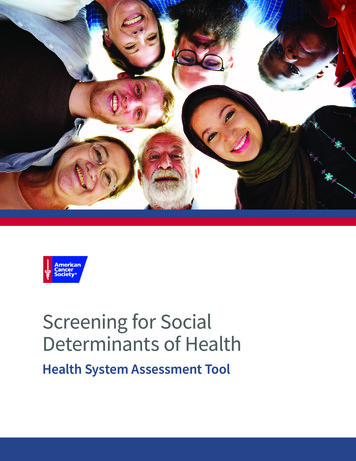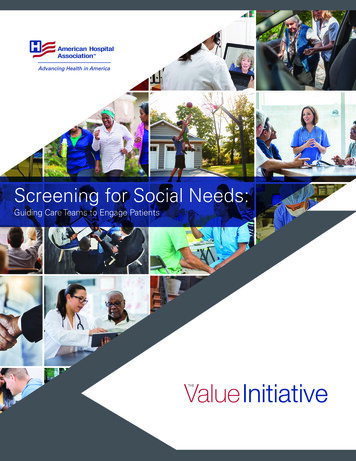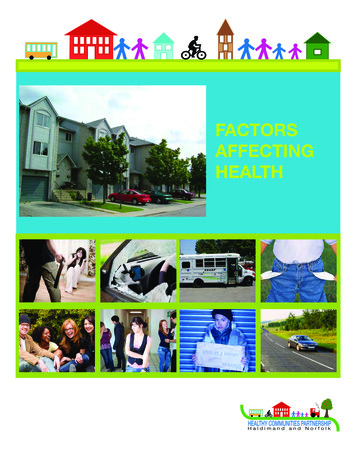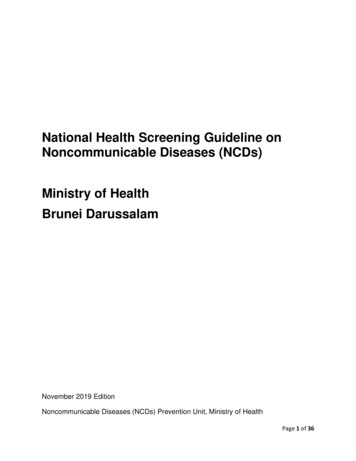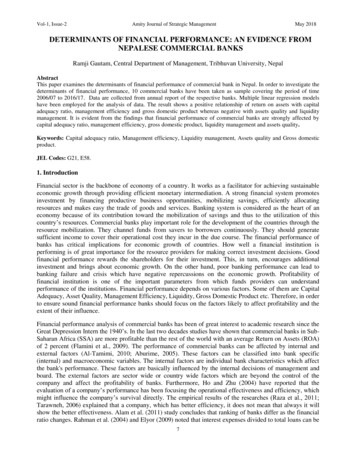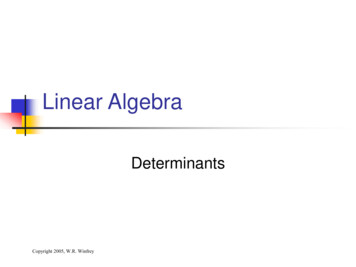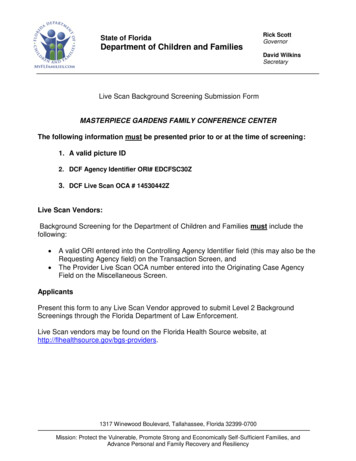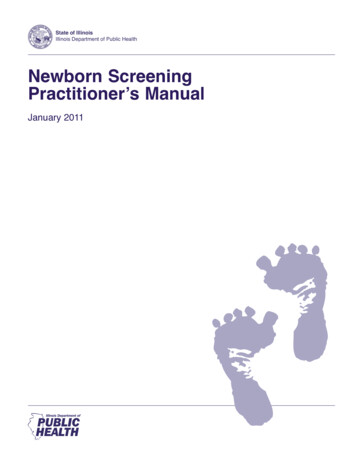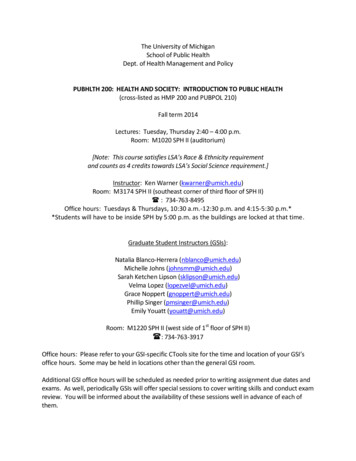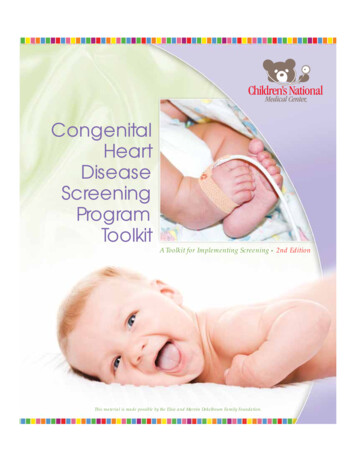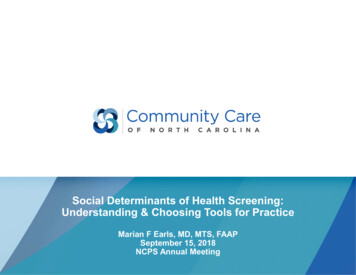
Transcription
Social Determinants of Health Screening:Understanding & Choosing Tools for PracticeMarian F Earls, MD, MTS, FAAPSeptember 15, 2018NCPS Annual Meeting
DisclosuresI have no relevant financial relationships with the manufacturer(s) of anycommercial product(s) and/or provider(s) of commercial services discussedin this CME activity. We do not intend to discuss unapproved orinvestigative uses of a commercial product or device.Marian F. Earls, MD, MTS, FAAP2
Robert Wood Johnson Foundation (RWJF)County Health Rankings rg/app/northcarolina/2016/rankings/3
Social Determinants of HealthExposureto hazardsSafety/violenceEmploymentIncome/PovertyWHO defines SDOH asthe circumstances inwhich people are born,live, and work, and thesystems in place to dealwith illness.Circumstances shapedby larger forces such aseconomics, publicpolicies, and politics.Stress,trauma,ACEUsing a Health Equity Lens. IMCoIIN Learning Session rom Kay Johnson4
WHO: Social Determinants of Health Social gradients Social support networks Stress Availability of healthy food Early childhood development Social exclusion Racism, discrimination Unemployment Air, housing & water Availability of healthtransportation Addiction Opportunities for educationand jobs5
Determinant Areas: Healthy People 2020 Economic Stability Education Social & Community Context Health & Health Care Neighborhood & BuiltEnvironment6
ACEs Areas Abuse Physical, emotional, sexual Neglect Physical, emotional Household Dysfunction Mental health, substance use, incarceration,separation/divorce7
ACEs Dose-ResponseChildren with 3 or more ACEs 3X academic failure6 or more ACEs 30X suicide 6X behavior problems 5X attendance problemsAdults with 4 or more ACEs 7X alcoholism 2X cancer 4X emphysema8
Three Levels of Stress Response9
Effects of Toxic Stress The activation of the physiologic stress response system results in increasedlevels of stress hormones Persistent elevation of cortisol, can disrupt the developing brain’s architecturein the areas of the amygdala, hippocampus, and prefrontal cortex (PFC), andtherefore ultimately can impact learning, memory, and behavioral andemotional adaptation Suppresses the immune response, affects other organ systems and makes aninfant, child or adult more vulnerable to infections and chronic healthproblems Different exposures to stressors at critical times can affect how a gene isexpressed (epigenetics) or how a pathway develops and subsequently thebehaviors and health conditions that are manifested over the life of that person10
CAHMI Technical Working Group on SDoHScreeningFrom Charles Bruner11
Examples of Social Determinants That ProtectHealth Parental knowledge and skills about Safe and good housingchild development and caretaking Stable/secure home life Good parental or caregiver physicaland mental health Positive father involvement Strong emotional bond orattachment between infant/childand parent/caregiver Social supports (ie., friends,neighbors, relatives, faith-basedgroups, and other agencies) High school education level orhigher for parents/caregivers Opportunities for stableincome/employment for household Food security for household Safe neighborhood with no violence Community resources for freshproduce, exercise, socialinteractions12
Strengthening Families’ Five ProtectiveFactors Model1.Parental resilience2. Social connections3. Knowledge of parenting andchild development4. Concrete support in times ofneed5. Social and emotionalcompetence of eningfamilies13
Protective Factors: CSSP & AAP Guidance the-Intersections Primary-Health.pdf14
Promotion of Protective FactorsExamples: Reach Out and Read Learn the Signs, Act Early15
The Conversation Screening is an opportunity to engage the family and to build trust Screening always involves a conversation Inquire about social determinants that are protective as well as those thatconfer risk The purpose is not to “solve” every issue immediately The question is “where should we start together?”16
National & State Landscape AAP Project: Screening in Practices HRSA: Healthy and Ready to Learn Initiative NCTSN: National Child Traumatic Stress Network Pathways – 3rd grade reading DHHS NC Early Childhood Action Plan DHHS SDoH 4 domains: food insecurity, housinginsecurity, transportation, IPV17
Recommendations Bright Futures Screenings Ask about parental strengths and Social Determinants of Health(SDoH) at every well-visit AAP Screening in Practices Project National Advisory Board and Project I-SCRN Developmental and behavioral (including social emotional), autism,perinatal depression, social determinants of health AAP Mental Health Psychosocial assessment (social-emotional, SDoH, ACEs) at every wellvisit Brief mental health update at acute visits18
Screening Resources The AAP Resilience Project ssessment-Tools.aspx The AAP Screening Website (STAR Center) SDoH ools.aspx The STAR (Screening Technical Assistance & Resource) Centerwww.aap.org/screening19
Tools with Multiple SDoH Areas Health Leads .pdf PRAPARE (Protocol for Responding to and Assessing Patients’ Assets,Risks, and Experiences) FQHCs WE CARE (Well Child Care, Evaluation, Community Resources,Advocacy, Referral, Education Survey Instrument) SEEK (Safe Environment for Every Kid) SWYC (Survey of Well-being of Young Children) Family Psychosocial Screen (Pediatric Intake Form)20
Tools for Specific SDoH Hunger Vital Sign Addressing Food Insecurity: A Toolkit for Pediatricians http://ww.frac.org/aaptoolkit Housing Stability Vital Sign21
Tools for ACEs Center for Youth Wellness (Nadine Burke, MD) Child Teen Teen self report The Children’s Clinic (RJ Gillespie, MD) ACE Score (parent) Resilience Score (parent)22
Health Leads ToolkitEssentialOptional Food insecurity* Child care* Housing instability* Education* Utility needs* Employment Financial resource strain* Health behaviors Transportation* Social isolation and supports Exposure to violence* Behavioral/mental health*Recommended tool has 10 questionsAdditional validated questions by category to expand or customize23
PRAPARE Items: 17-21 Areas Domestic violence Education Employment Family Member Incarceration Financial security/stress Housing Safety Stress Transportation24
WE CARE Items: 6 Areas: Childcare Education Employment Food insecurity Housing25
SEEK Poison control Smoking Food insecurity Discipline/behavior Depression Domestic violence Substance use26
SWYC Family Questions Smoking Substance use Food insecurity Depression Domestic violence Reading27
Family Psychosocial Screen Items: 56 Areas: Caregiver education Family history Health habits – safety, domestic violence, guns, smoking Substance use Parental childhood experiences – discipline, abuse, neglect Depression Support system28
NC DHHS 4 domains Food insecurity Housing insecurity Transportation Interpersonal Violence New health plans will be expected to screen for these and to link to andsupport community resources NC Resource Platform29
CYW: 3 Forms Section 1 – 10 questions (original ACEs) Section 2 - 7-9 questions (additional early life stressors) Scoring: Section 1 plus Section 2 If 0-3 without symptomatology – anticipatory guidance If 1-3 with symptomatology OR 4 – refer for treatment30
The Children’s Clinic ACE Score Resilience Score Comments, Questions and Concerns Interest in Resources31
The “New Mexico Three” Has anything major (traumatic, etc - use your own terms) happenedsince the last time we've met If so, how has it had an impact on you and your family (again, whateverscope is appropriate) Despite that, what's been going well for you32
What We Are Learning Routinely eliciting patient/family strengths is transformative to practice Clinicians and patients/families can discuss social determinants - thosethat increase risk, and those that are protective Adverse Childhood Experiences (ACE’s) are common, but resiliency canameliorate their impact Trauma-informed care needs to include a focus on promotion andprevention as well as intervention Engaging the patient/family as a partner is key Promoting Resiliency is central to addressing social determinants ofhealth33
Coding ConsiderationsHealth Risk Screen 96161 - of the caregiver for the benefit of the patient; e.g. maternaldepression screening with the Edinburgh 96160 – health risk screen for the patient; According to AAP codingguidance, if the screen has a mix of questions, the code would be 96160Tracking and population management Assistance with resource planning Use of Z-codes that align with SDoH or ACEs (see handout)34
35
Social Determinants of Health Screening: Understanding & Choosing Tools for Practice Marian F Earls, MD, MTS, FAAP September 15, 2018 NCPS Annual Meeting. . Stable/secure home life High school education level or higher for parents/caregivers Opportunities for stable income/employment for household
